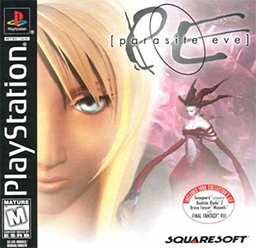We Interrupt These Parasites to Bring You God.
The Survival Horror genre witnessed a huge surge of interest due to the original Resident Evil. This generated enough sales that other companies started to get in on the popularity. One of those companies happened to be the hugely successful Squaresoft. At a time when they were branching beyond RPG's, Squaresoft created their own version of a Resident Evil clone that took the shape of Parasite Eve. I decided I wanted to get this game, and after a few months of it being out, I did.
I had a cousin that I played a lot of the PS1 era with. Almost weekly I'd head over to his place and we'd play whatever we had at the time, or even just fire up the old SNES and play some games of the past. This cousin was always NUTS for things to do with horror or horror movies. Thing is, their home was always full of younger brothers, nephews and nieces, so it is not the "best" place to try and be immersed into a game. So I set it up that the day I get Parasite Eve, I have the cousin over so we can play a marathon session of it. All things go according to plan, I get the game, we get to my place, and turn off all the lights and we get ready to play.
And then I crack open the case and find a demo disc.
I have this thing... when I get a game, I like to build the anticipation... I guess? I do not know. Its way worse now, I will sometimes go weeks without starting a game I've bought. I have to get in the mood to start a game. Anyway, it was not so worse back then. A demo disc was the only way we had back then to see actual video footage of new games. In a way, its like anticipating movie trailers before the big blockbuster you've waited 2 years to watch. Anyways, my cousin hated this bullshit, and boy did he have the perfect storm of delays hit...
"Oh this is a game demo. Hey, I know you're waiting to watch this game you really really want to see, but let's just at least watch the opening for this X.. zee, this Xenogears, it looks like it has a robot". I had never even read a preview about the game, knew nothing of it.
Yep. Xenogears. My most favorite game of all time. I used to think every 4 years something would come out to top my last favorite game of all time. Nope. Still going strong. Anyway, so we watch this intro thing and it ends with "You Shall Be As Gods"You Shall Be As Gods"You Shall Be As Gods"You Shall Be As Gods"You Shall Be As Gods"You Shall Be As Gods"You Shall Be As Gods"You Shall Be As Gods"You Shall Be As Gods"You Shall Be As Gods"You Shall Be As Gods"You Shall Be As Gods"You Shall Be As Gods"You Shall Be As Gods"You Shall Be As Gods"You Shall Be As Gods"You Shall Be As Gods"You Shall Be As Gods"You Shall Be As Gods"You Shall Be As Gods"You Shall Be As Gods"You Shall Be As Gods"You Shall Be As Gods"You Shall Be As Gods"You Shall Be As Gods"You Shall Be As Gods"You Shall Be As Gods"You Shall Be As Gods"You Shall Be As Gods"You Shall Be As Gods"You Shall Be As Gods"You Shall Be As Gods"You Shall Be As Gods"You Shall Be As Gods"You Shall Be As Gods"You Shall Be As Gods"You Shall Be As Gods"You Shall Be As Gods"You Shall Be As Gods"You Shall Be As Gods"You Shall Be As Gods"You Shall Be As Gods"You Shall Be As Gods"You Shall Be As Gods"You Shall Be As Gods"You Shall Be As Gods"You Shall Be As Gods"You Shall Be As Gods"You Shall Be As Gods"You Shall Be As Gods"You Shall Be As Gods"You Shall Be As Gods"You Shall Be As Gods"You Shall Be As Gods"You Shall Be As Gods"You Shall Be As Gods"
And I flip my shit. I make him wait the hour or so it takes me to finish the demo because now I can give less than 2 shits about Parasite Eve, I just played what could be the most amazing "holy shit!" demo of a game I've ever played.
We did end up putting about 4 hours on Parasite Eve that day. I even let him play the majority of time we put in(I knew i'd be starting over later before I finished it). I really really liked Parasite Eve when I played it, its a wonderful game. But I'll never forget that hurt puppy dog look on his face when I said "ok, I can't just stop at the opening cinematic... I'm playing the demo."


























